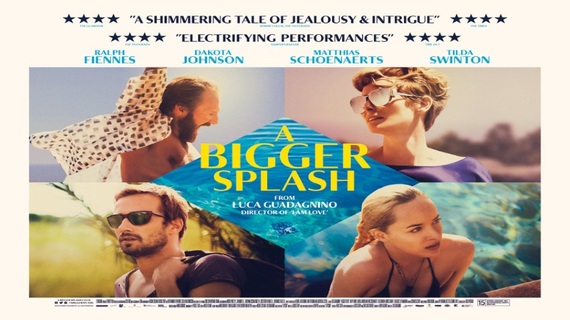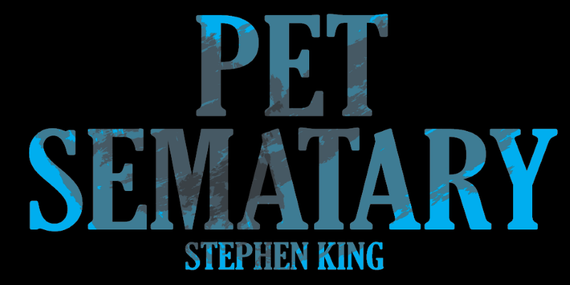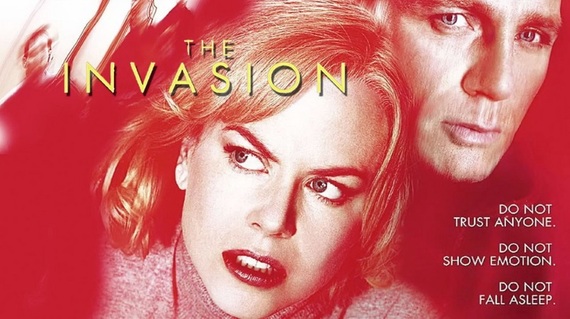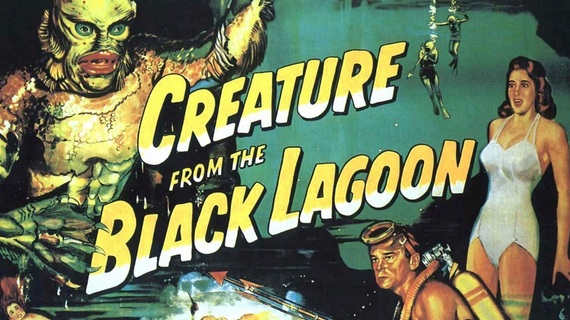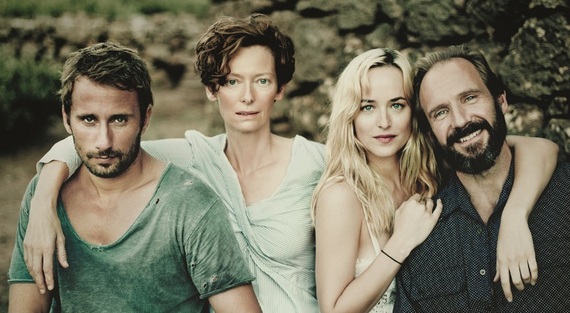This Post originally appeared on the blog ScreenCraft. ScreenCraft is dedicated to helping screenwriters and filmmakers succeed through educational events, screenwriting competitions and the annual ScreenCraft Screenwriting Fellowship program, connecting screenwriters with agents, managers and Hollywood producers. Follow ScreenCraft on Twitter, Facebook, and YouTube.
David Kajganich came to filmmaking from a background in literature, having first trained as a fiction writer at the prestigious Iowa Writers Workshop. Since beginning his career as a screenwriter, he has written projects for nearly every major studio, most recently the film True Story, which starred Jonah Hill, James Franco, and Felicity Jones. He is currently writing a film about New Orleans in the wake of Hurricane Katrina for producer Scott Rudin, and a dramatic series for AMC about the disastrous 1845 Franklin Expedition to find the Arctic’s Northwest Passage.
He has written for big studio films like Invasion, the in-development Creature of the Black Lagoon, and has written adaptations of Stephen King’s Pet Sematary and It.
He also wrote the acclaimed film A Bigger Splash. The film tells the story of rock legend Marianne Lane (Tilda Swinton), who is recuperating on the volcanic island of Pantelleria with her partner Paul (Matthias Schoenaerts) when iconoclast record producer -- and old flame -- Harry (Ralph Fiennes) unexpectedly arrives with his daughter Penelope (Dakota Johnson) and interrupts their holiday, bringing with him an A-bomb blast of nostalgia from which there can be no rescue.
ScreenCraft: How, when, and where did your storytelling roots begin?
David Kajganich: I can’t remember ever wanting to do anything else but write, honestly. I grew up in a fairly rural place in the Midwest, but was fortunate to have one of those almost warehouse-sized used bookstores in the next town over -- the sort of place that barely exists anymore -- and to have parents who really never said no to buying books.
So I read constantly as a kid. Whatever looked interesting, I’d read -- a crazy, crazy mix of things. I hadn’t been taught yet to rank authors against one another, so Robert Silverberg and Umberto Eco shared the shelf with equal authority. At 13, I thought Edith Pargeter was the height of cool. It was great.
So it didn’t surprise anyone in my family that I ended up studying writing. I finished grad school thinking my career would be some combination of writing novels and university teaching, and that was the path I was on, quite happily, when I happened to walk into the right movie theater on the right day and had an experience that changed the trajectory for me.
It was a triple bill of Kieslowski’s Blue, White, and Red. I was so moved and intrigued by those films I thought it might be interesting to write a screenplay just as an exercise, to try to understand how a visual medium might inform a textual one. So I wrote one, fell in love with the form, and started using my free time to work on scripts rather than fiction.
ScreenCraft: What was your first big break as a screenwriter?
David Kajganich: When I was first starting out, I wrote three spec scripts over about three years. The first two were character dramas that incorporated certain elements of genre, but for the third I thought I would write a full-on genre film that might be easier to get people behind it. It was a period horror film called Town Creek. Several studios bid on it and it ended up selling to Warner Brothers, who also offered me a blind script commitment along with it. That was a huge break, because it meant I could move to Los Angeles from the Midwest where I’d been teaching knowing I had both a sale behind me and a job ahead of me. I’m not sure I would have left my previous life without that reassurance, knowing how difficult it is to break into this business.
ScreenCraft: How did you go about attaining representation?
David Kajganich: My first spec script was written with a good friend. Neither of us knew anyone in the industry, so we spent a couple of years submitting it to as many places as we could find that would read cold submissions, and were actually able to option it to a production company in Los Angeles for a time. That lead to nothing, but it did give us confidence. I wrote a second spec on my own and from that was able to secure an agent, manager, and lawyer while still living in the Midwest. It was the Rube Goldberg version: A friend read it and passed it to a friend he’d met at a film festival who worked at the front desk of a small production company who passed it to his boss, who passed it to her friend who was a junior agent -- and the rest proceeded from there.
ScreenCraft: You've had the opportunity to adapt two of my favorite writer's novels; Stephen King's Pet Sematary and the upcoming It. What are the keys to writing a compelling adaptation from such a celebrated author?
David Kajganich: I’m not sure I’ve found any keys -- since I keep writing them and studios keep not making them -- but I can tell you what kept emerging for me as a central insight. I think it’s crucial, with King in particular, to try to approximate in the script what it feels like to read The Stand or It or Pet Sematary for the first time.
That simultaneously intimate and epic feeling of a familiar world and everyday people being overtaken by the uncanny. There’s really no one who does that better than King, and it happens in a very particular way in his books -- under the cover of these extended, humanely observant Sherwood Anderson or Garrison Keillor-esque character profiles. So, I think paying close attention to the way he builds character as much as the way he builds horror in his books is one of the most important components, for sure.
ScreenCraft: Does the source material help or hinder you when condensing it into a two-hour movie?
David Kajganich: It would feel like a massive understatement to say it merely helps. Without question, the source material should be the soul of an adaptation, even if it can’t be its body. Given that I studied fiction and not film, I have a reverence for books and how they’re put together that has probably trained me to spend even more time trying to unpack a text and its author’s intentions than maybe other screenwriters do when they write adaptations.
I’ve certainly made extensive changes to the structures of some of the books I’ve adapted, but never in a vacuum. I’ve always tried to use the texts to guide these choices -- especially the psychologies of the characters as they were originally conceived, and what it felt like the writer was trying to say about one particular way the world can work. I find the more I work with a text, the more I admire it and it becomes harder to break and reset its bones, even though that is exactly what I’m being asked to do, and must do. It’s a great responsibility if you care to do it respectfully.
ScreenCraft: What was it like to write a big studio remake of a classic with Invasion?
David Kajganich: Up until post-production, it was a fantastic experience. I wrote a script that took the ambiguous allegory of the original book and tried to apply it to living inside of the Bush administration, post 9/11.
Agendas were being executed behind a smoke screen of rhetoric that mischaracterized -- or completely obscured -- them. And, as we now know, these were not agendas for the common good. Rich people got richer. Bystanders’ lives were destroyed. When it was first beginning, it was hard to parse out the facts from the fiction, let alone how to hold anyone accountable, or even who that should be.
It felt like the Body Snatchers mythology spoke to that. The director, Oliver Hirschbiegel, who was coming off Downfall, was very collaborative and respectful of the script. We had a superb cast and some legendary department heads on our team. It was an intense first film experience for someone new to the industry.
I was on set quite a lot and we shot the script as written. By design, and in keeping with the Body Snatchers ethos, our final five minutes were rather ambiguous. Warner Bros. and Joel Silver, who had supported that ending on the page, second-guessed it on film, and after a long back and forth decided to bring in the Wachowskis to rewrite the ending.
A couple weeks later, I got the reshoot pages as a courtesy and was astonished to find half the script had been rewritten. The pages seemed like they were from a different movie entirely. Department heads were emailing me with their confusion and condolences. When it came time to finalize the writing credits, the Wachowskis declined taking one, and if I wanted to take my own name off the film -- which I did -- I was told it was going to cost a lot of money and would piss off the studio. I was new. I didn’t know what to do. I didn’t want my name on a film that had been second-guessed to death, but I didn’t want to make enemies, either. The whole experience went from being a terrific, respectful collaboration to being a nightmare of competing allegiances.
ScreenCraft: You're listed as one of the writers of Universal's Creature of the Black Lagoon. Can you share some experiences with the work you've done on that script? Is it part of Universal's upcoming shared monsters universe?
David Kajganich: It may seem hard to believe, but I have no idea if any part of my script is being used currently or not. That’s a surreal part of writing for a studio. They own what you’ve written and can do with it whatever they choose, with no obligation to keep you informed.
I did two drafts a number of years ago now, so I imagine they’ve probably started over since my drafts did not in any way connect the mythology of the Black Lagoon to the rest of the monsters in the Universal stable. That concept came after my involvement. It’s definitely the most commercial script I’ve done, but it was a shitload of fun to research and write. It was a ride through the kind of 70s-style id-based horror I grew up loving.
ScreenCraft: There's a lot of great buzz about your film that you wrote and executive-produced -- A Bigger Splash. Can you tell us where the story originated from?
David Kajganich: The film is very loosely based on a 1969 Jacques Deray film called La Piscine, which was a sort of cinematic style piece in its day. Alain Delon and Romy Schneider, post-divorce. Enough said. Studio Canal owned the rights and had approached the director, Luca Guadagnino (of I Am Love fame), several times about remaking it, but he wasn’t so keen at first to do it.
Luca had been reading scripts for other possible jobs and came across two of mine, which he liked, and he called me to see if I’d watch the original film and tell him what I thought. After watching it, I was confused why anyone would want to remake it, and I decided to be honest and tell him that. He said that was the answer he was hoping for, and asked if I’d like to help him try to find some unexpected third rail to ride into the basic shape of the film and build something totally different and -- as he put it -- rock and roll.
ScreenCraft: How much did the amazing casting of Tilda Swinton and Ralph Fiennes, as well as the rest of the cast, elevate the characters that you wrote?
David Kajganich: You can’t imagine what it means to have an actor like Ralph Fiennes take a character you’ve written and step into it with dedication, focus, generosity, and respect. Actors have to grow their characters emotionally past the margins on the page, but it doesn’t mean they all do it organically, or with a collaborative spirit. In the case of this film, these actors were wonderful in that way, and also encouraged by Luca to build the characters in full dialogue with us. Luca creates a culture of collaboration on his films, so he made sure there was lots of time to discuss these characters all together, and I was able to make many little tweaks and adjustments to deepen them based on how the actors wanted to inhabit and personalize them. It was a fantastic experience.
ScreenCraft: What is it like to go from screenwriter to the Executive-Producer role as well? What did that role entail for you?
David Kajganich: The Executive Producer credit on this film came entirely as a result of Luca being such an open and collaborative director. I ended up being a part of nearly every phase of the production, including post. I was there for a lot of the scouting, for physical prep, and for prep with the actors.
During the shoot, I was on set every day making tweaks and adjusting to production needs. And I was also in the editing room with Luca and Walter quite a lot, and for some of the ADR sessions. This is how Luca likes to work, and it requires so much trust between the writer and director, and such a level of openness, I can understand why it’s rare.
In my experience, directors aren’t usually built this way. Where most directors I’ve met have this fever of ego and insecurity, Luca has a great sense of play and fairness.
So it just became clear at a certain point my contributions were extending past the job description of being the screenwriter and Luca wanted to make sure that was reflected in the credits. At one point I was driving hell for leather across Pantelleria with a car full of film to get it to camera for the next set up thinking “there is nowhere I would rather be than right here, right now, doing this” because it really did feel like a family endeavor at that point.
ScreenCraft: Are the characters from A Bigger Splash based on any real life figures within the music industry?
David Kajganich: We wanted very much to have these characters ring true for people who’ve stood in the same corners of the music industry Marianne and Harry are meant to have occupied. Luca, Tilda, and I talked about a range of references for Marianne to understand the outside boundaries of the terrain we wanted her to exist in -- Patti Smith, Chrissie Hynde, David Bowie, PJ Harvey, Róisín Murphy, among many others.
For Harry, the first task was to find the right moment in The Rolling Stones’ career to slot him into -- which ended up being the very beginning of the Don Was era -- so I looked closely at first-person accounts of the recording of those albums. We had extremely helpful assists, both from Ralph’s brother Magnus, who is himself a music producer, as well as several members of the Stones who took an interest in the project and reached out to us to adjust some details in the script to more accurately reflect their own memory of events.
As well, a great friend of the film’s was a former editor of the Italian Rolling Stone magazine, Carlo Antonelli, and he had quite a lot of insights I pulled into the script about the state of rock and roll from his many years of relationships with musicians and producers. And as more collaborators came on who’d lived through that era in the music business -- I made sure to talk to and confirm that Harry felt like a familiar character to them, and made tweaks accordingly.
ScreenCraft: What is the best piece of screenwriting advice that you've picked up along the way?
David Kajganich: People write out of such different motivations, but the one thing I would say to any screenwriter -- regardless of how pure or cynical are his or her goals -- is to cultivate the habit of a strong point of view. Obviously you want your connection to your own work to be deep and aggressive, but, speaking practically, I think writers give up a great deal of power by waiting for other people to tell them what a project is, or how it should work -- for fear of being perceived as wrong somehow. Or by writing scripts that are diluted in their vision because they are attempts to copy what’s already in fashion.
You don’t want to be overly deferential in this business -- either to the bosses or to the zeitgeist -- and the best way to keep that from happening is to have a strong, earned, sincere point of view about everything regarding the work. And if you don’t naturally have one, do the heavy lifting to find it.
ScreenCraft: What's one of your favorite Hollywood anecdotes that you experienced early in your career, and what did you learn from it?
David Kajganich: When I first moved to LA, I pulled up to the red light at Fairfax and Santa Monica next to David Lynch and nearly wrecked my truck in a moment of extreme fandom. I mean, I was stopped, with my foot on the break, and I still somehow ended up almost t-boning someone. Then he turned to see who the dipshit was causing all the commotion and I realized it wasn’t David Lynch at all, just some guy with a side fade in an old Buick. Lesson learned: In LA, keep your eyes on the road.

